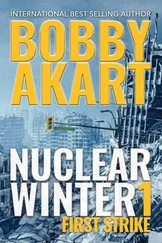Years ago, the U.S. government had begun selling off its decommissioned military vehicles. Monroe County had purchased four urban assault vehicles that had never been used except in training exercises. Team A now operated three of them to undertake the initial breaches of the buildings. The fourth remained at the administration building together with a sizable security contingent. Lindsey wanted her castle protected.
The urban assault vehicles raced toward the one-story structure at a fairly high rate of speed. At that hour of the morning, very few people were awake, but the hyped-up drivers were at their highest state of awareness.
After skidding to a stop, three men emptied out of the rear of the vehicles and approached the front entrance. The breach team was made up of SWAT team members and firefighters experienced in extraction methods.
Three SWAT team members with automatic weapons arrived at the plywood-covered plate-glass doors and windows facing the parking lots. The firefighters used cordless saws and their Halligan tools to cut through the plywood. A Halligan was a steel tool used by firefighters and law enforcement when forcible entry was required in an emergency. One of the most important fire rescue tools, it had a two-prong fork used as a claw on one end and a combination spike-duckbill on the other.
With incredible efficiency, the firefighters on team A removed all the sheets of plywood that had been installed to protect the building from the storm and looters. Seconds later, without regard to the damage they were causing, they broke out the panes of glass, allowing the SWAT team members easy access.
Illuminated flashlights sent beams of light dancing throughout the interior of the building. The law enforcement officers called out to anyone stowed away inside, warning them to show themselves or risk getting shot. In less than five minutes, team A had breached the largest restaurant supply store in Key West and gave the all-clear announcement.
Pleased with himself, Sergeant Rivera ordered the other teams to move in, and with the efficiency of a swarm of locusts in a wheat field, they stripped the business of anything left of value.
A large crowd of onlookers gathered at the first target and each location thereafter to beg for a handout or to enter the buildings after the MCSO teams pulled out. They were emaciated and suffering from illness brought on by the lack of nutrition. Their dark, sullen eyes told the story. They were days away from starving to death after running out of their own food supplies.
Sergeant Rivera tried to put the images out of his mind. Their desperation emboldened him to move on to the next target on the list. And the next. And the next. By the time they reached Gordon Food Service on Roosevelt Boulevard, word of the raids had spread throughout Key West. At each stop, the crowds not only became larger, but some also cheered on the SWAT teams.
Thrilled at the success of his raids, Sergeant Rivera and his three armored assault vehicles rolled into Conch Plaza to enter the Gordon Food Service Store. What they encountered was more than resistance. It was a full-frontal assault by the owners and their hired guns.
Tuesday, November 12
Tarpon Harbour Apartments
Marathon
Don Wallace and his wife had managed the Tarpon Harbour Apartments for more than ten years. Like so many other Keys residents, the Wallaces either came to the island chain in search of a Margaritaville lifestyle, or they were hiding from a past they didn’t want exposed. The Florida Keys had many transients in search of a new life, and the Wallaces fell under that category.
Wallace lived in the manager’s apartment located on the property on the Atlantic Ocean side of Marathon. They were friendly with all of their tenants and spent a considerable amount of time organizing community events for the one-hundred-and-seven-unit complex.
On this day, the meeting at the complex’s clubhouse wasn’t set to beach music and free margaritas. It was about survival of the fittest.
Wallace had approached several of the men and women at Tarpon Harbour who’d run out of food. They reached an agreement, one that was born out of instinct. They refused to die and decided to band together to take what they could not buy—fresh water and food.
Several tenants had young children who were suffering. Wellness checks on the tenants in residence began to produce dead bodies daily. Wallace and the tenants began breaking into nearby homes and businesses, taking anything edible and distributing the food products to those in need within the apartment community.
On a few occasions during these home invasions, they were met with a homeowner and a rifle barrel. This prompted the band of burglars to locate weapons of their own. At first, they used aluminum baseball bats and claw hammers to subdue their victims. With each successful nightly set of break-ins, they not only scored food but also guns.
None of the men owned weapons of their own, and very few had ever fired a gun. However, they were prepared to do what it took to continue to feed their families and those in the apartment complex.
Wallace called the group together. What started as a close-knit band of six burglars had now expanded to a dozen. Eight of them were armed with multiple guns. They gathered in the teal-colored clubhouse overlooking the pool, which remained filled with sand and debris following the hurricane. Wallace had only had enough time to cover the windows with plywood and had been unable to put away the lounge chairs that had lined both sides of the pool. The group was talking among themselves as Wallace called them to attention.
“Okay, listen up. We’ve now confirmed that the sheriff’s department has pulled virtually all of their manpower to Key West. From what we’ve been told by a firefighter who left to join the sheriff’s department, the mayor has ordered raids of businesses in Key West and Stock Island. This firefighter friend of mine says the plan is to redistribute the food and supplies to residents.”
“How does that help us?” asked one of the men who stood in the back of the open space.
“I don’t think it does, for now, anyway,” replied Wallace. He ran his fingers through his salt-and-pepper hair. “According to my buddy, they plan on moving up the Keys until they’ve emptied every place that would have stockpiles of supplies. I think we need to change our tactics before they hit Marathon.”
“What do you have in mind?” asked one of the three women who were a part of the group.
“Well, so far we’ve focused on residences nearby. Mainly, this is because we can hit them and run back to the apartments before we’re seen. I think we need to identify the locations in Marathon that would give us the greatest opportunities and get what we can before the mayor beats us to the punch.”
Wallace pulled out a tourist map of Marathon and spread it on a banquet table in front of him. The group walked up to the table to get a better look at the markings and Post-it Note flags he’d used to identify certain properties in Marathon.
“We don’t have a lot of time if I understand my friend correctly, so we need to hit our most lucrative opportunities first,” Wallace began to explain. He tapped his fingers on the map over Marathon High School. “When this whole mess started, the county maintenance people put heavy-duty chains and padlocks on all the exterior doors to prevent entry.”
“Do we have bolt cutters strong enough to cut through the chain?” one of the group asked.
“No, but I do have an alternative way into the school,” replied Wallace. He stood away from the table and studied the people he would rely upon to break in. “At the food service entrance between the classroom buildings and the community college, there are three roll-up doors that allow delivery trucks to back up to a loading dock.”
Читать дальше












